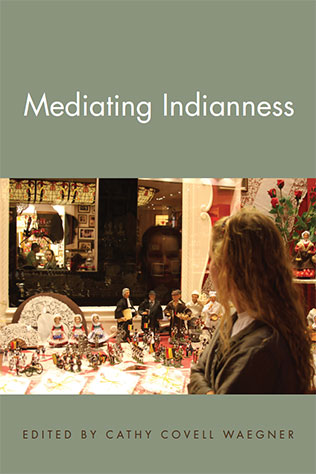Volume Description
 Mediating Indianness investigates a wide range of media instruments, such as print, film, stage play, ritual dance performance, music, recorded interviews, orality and alphabetization, photography, rhetoric of treaty-making (and -breaking), and virtual networking, which have been used in exploitative, informative, educative, sustaining, protesting, and/or entertaining ways to negotiate Native American identities and images.
Mediating Indianness investigates a wide range of media instruments, such as print, film, stage play, ritual dance performance, music, recorded interviews, orality and alphabetization, photography, rhetoric of treaty-making (and -breaking), and virtual networking, which have been used in exploitative, informative, educative, sustaining, protesting, and/or entertaining ways to negotiate Native American identities and images.
The project team gathers (Native) American and European (German, British, Romanian) scholars, an interdisciplinary group of both senior and junior academics from the fields of cultural and literary studies, anthropology, rhetoric, and creative writing. The initial findings were presented or performed in a four‐panel format at the 2012 MESEA (Society for Multi-Ethnic Studies: Europe and the Americas) conference in Barcelona/Spain. The “Creative Correspondences and Virtual Affiliations” contribution by leading Native American Studies scholars, in the volume with a poetic response by Gerald Vizenor, is a particularly successful experiment in inventive academic discourse. Mediating Indianness includes a review by A. Robert Lee of Gerald Vizenor’s latest prose work Blue Ravens: Historical Novel (Wesleyan University Press, 2014).
The title of the project and this volume was chosen with care. The selection of a potentially essentialist term like “Indianness” is deliberate and indeed points to the intricate construction of ethnicity as filtered through media, despite frequent assertions of “authenticity.” From William ‘Buffalo Bill’ Cody’s claim, extravagantly advertised on both sides of the Atlantic, that he was staging “true-to-life” scenes from Indian life in his Wild West shows (1872-1908) to contemporary Native hip-hopper Quese IMC’s announcement that in his engagé songs he tells his people’s “own history” and draws on their ‘true’ culture, media of all types has served to promote disparate agendas claiming legitimacy. The volume does not shy away from the issue of evaluation and how it is only tangential to medial artificiality, in offering explanations of why, for instance, the multi-media blitz of Eric Gansworth’s 2010 innovative play Re-Creation Story is perceived as conveying viable and valuable Indianness.
The active mediation which can expose the construction of stereotyping and stir up processes to loosen the perception of Native Americans from standardized surfaces, is the strategy of the Native artists and writers dealt with in this volume, as well as, on a meta-level, the tactic of the scholar-contributors presenting their analyses. This “upset” is stressed in the book through the concept of “refracting” which the cover photo, “Indigenous Indices of Refraction, Brussels 2012” by Kimberly Blaeser, embodies so richly. Mediating Indianness thus emphasizes forms of deliberate refraction and creative mediation. As one reviewer has said, “I was struck by how flexible and alive this collection was, purposely unsticking, unsealing, so many working assumptions about Native identity and culture. As I read I felt that lift from old concepts, old ways of seeing history, experience, and prior scholarship. This collection tilts toward a vibrant, ever-changing future where Native peoples are located within a complex intersection of cultural influences” (Susan Power, author of Sacred Wilderness).
Early Reading Responses
“This volume is as crucial as it is timely, and it is so precisely in its fusion of historical research with astute descriptions of contemporary Native American life.” Mita Banerjee, Director, Center for Comparative Native and Indigenous Studies, Johannes Gutenberg-Universität Mainz, Germany Read the full response
“Theoretically sophisticated, the assembled essays create a veritable palimpsest of readings by Native scholars, European experts, and creative artists.” John Wharton Lowe, Barbara Methvin Distinguished Professor, University of Georgia Read the full response
“Mediating Indianness is an exemplary project arising from a fruitful international dialogue at the current intersections of ethnic and media studies.” Klaus Zilles, Blanquerna School of Communication and International Relations, Barcelona, Spain
“I was struck by how flexible and alive this collection was, purposely unsticking, unsealing so many working assumptions about Native identity and culture.” Susan Power, author of Sacred Wilderness
“Mediating Indianness offers a cornucopia of voices proclaiming that Native American identity is alive, expressive, and still under construction. . . . Standing behind the volume, visible here and there in shadowy form, sometimes stepping out into the light, is the archetypal figure of the writer and activist Gerald Vizenor.” Paul Spickard, author of Almost All Aliens and Multiple Identities Read the full response